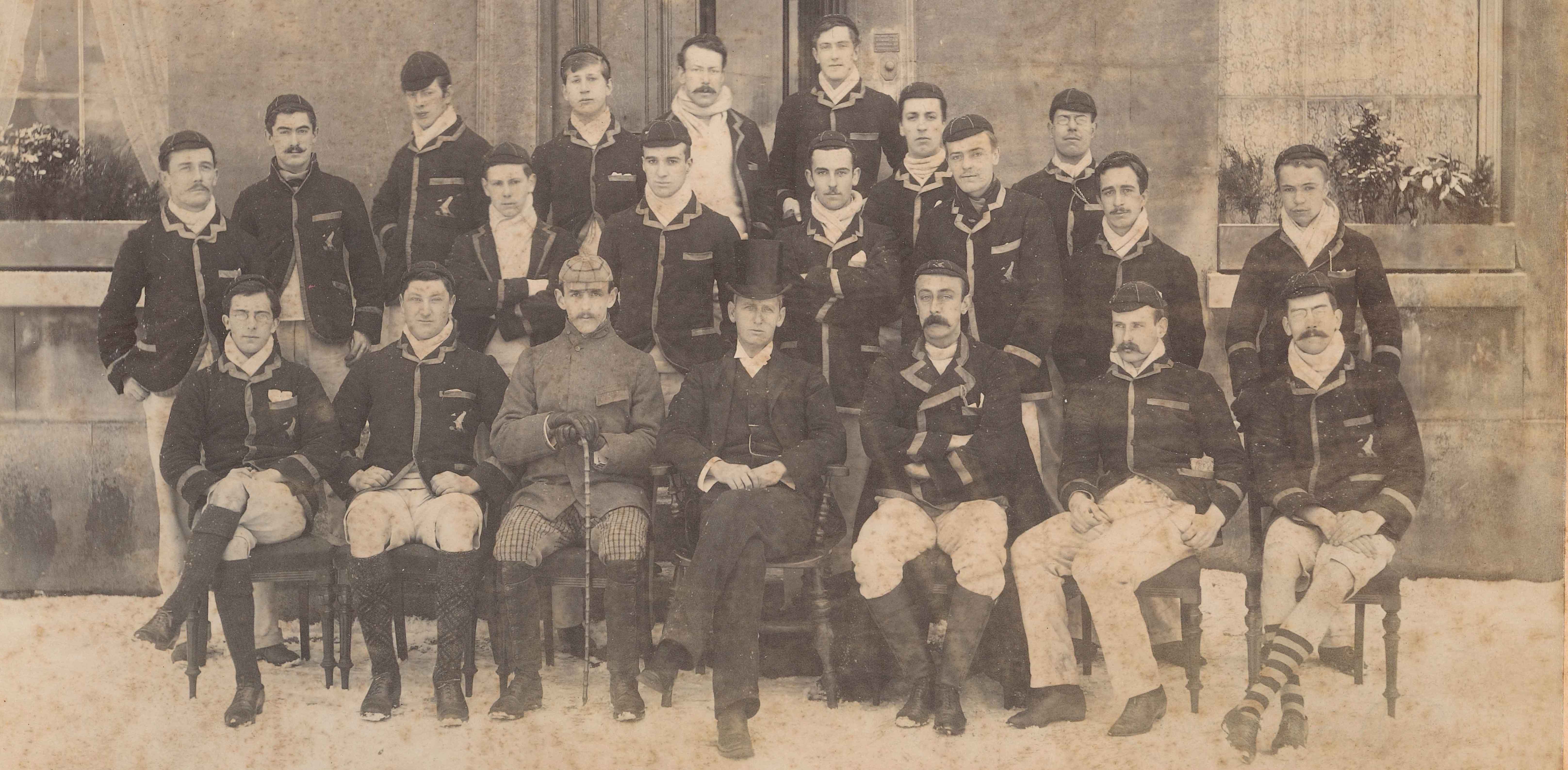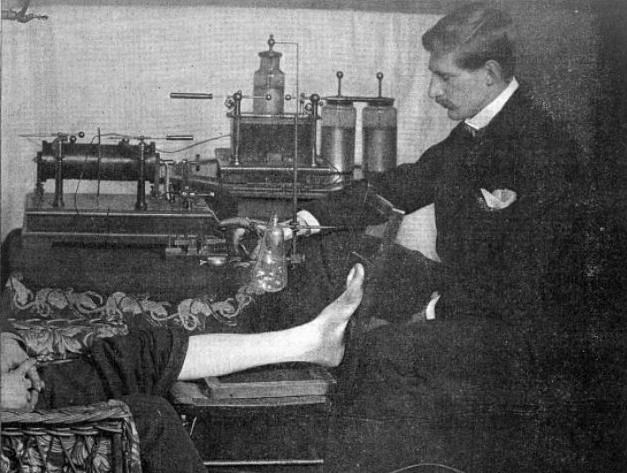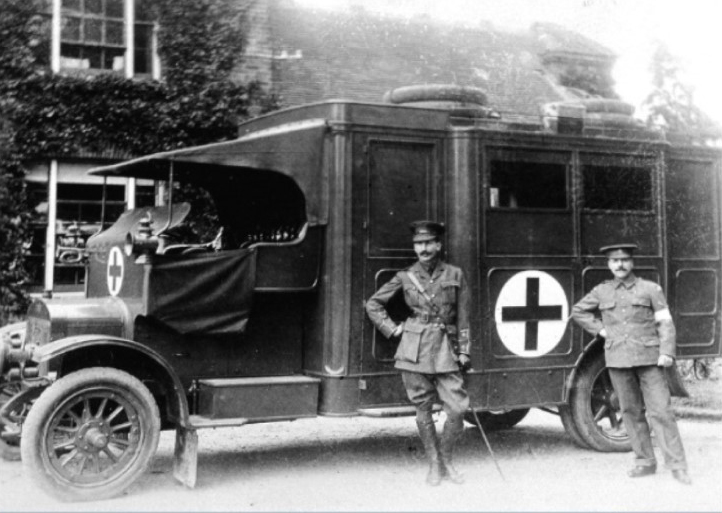Major Sydney Domville Rowland (1872-1917)
First World War Roll of Honour
“friends know a fine unselfish man who made the world happier for being in it” Obituary, Journal of Pathology, Vol. xxi, 1918
Sydney Domville Rowland was born in March 1872, the eldest son of the Reverend William J. Rowland and his wife Margaret of Flushing (near Falmouth), Cornwall. From 1873, he lived for a number of years in India where his father worked in a number of locations including Fort William, Calcutta (now Kolkata) and Darjeeling. His father became vicar of Stoke sub Hamdon in 1884.
Rowland came to Downing in 1889 with a Minor Scholarship from Berkhamsted School, where he was in School House from 1885-1888. The photograph (above) from the album of one of his contemporaries at Downing (ref DCPH/8/1), shows Rowland (in the centre, with pipe) towards the end of his first year in May 1890. He was a member of the College’s Boat Club, and also features in a rare surviving photograph of the Boat Club trials in November 1890 (below, 2nd from left, back row). Whilst at Cambridge he was President of the Natural History Society, and for a short time an assistant demonstrator in the Physiological School. He graduated 1st Class, Natural Sciences Tripos Part I, 1892, and 2nd Class, Part II, in 1893.

After taking the first and second M.B. at Cambridge, Rowland continued his medical education as a Shuter Scholar at St. Bartholomew’s Hospital, London from 1894, qualifying M.R.C.S., L.R.C.P. in 1897, although he never took his university degree. While in London he developed an interest in the development of the new field of x-rays and was one of the first to publish on the developing field of radiology, editing the Archives of Clinical Skiagraphy (a forerunner of The British Journal of Radiology) in 1896. He also published in, and was part of the editorial staff of, the British Medical Journal under his uncle, Dr Ernest Hart, its Editor.

An interest in bacteriology lead him to subsequently join the staff of the Lister (then Jenner) Institute of Preventive Medicine, at Elstree, as an Assistant Bacteriologist in 1898. Rowland remained working for the Lister until his death in 1917.
In additional to his work in bacteriology, colleagues later remembered his ability to solve technical problems and his mechanical skills, which he successfully applied to motor cars. He was also a talented pathologist.
In 1905 Rowland was seconded by the Lister Institute to the Commission for the Investigation of Plague in India in an attempt to prevent and control the spread of bubonic plague. During his work in India with members of the Indian Medical Commission and the Lister Institute, he helped to establish the transmission of plague by rat-fleas. He returned to the Lister Institute in 1908, and a year later was again seconded to the Plague Commission, and worked in this country upon the problem of plague prophylaxis, making important contributions both to the immediate knowledge of vaccination against plague and also the wider questions of immunity. Later Rowland was assigned to investigate an outbreak of pneumonic plague (later identified as plague bacillus), in Freeston village, East Suffolk.
At the outbreak of war, he volunteered his services and, in September 1914, he obtained a commission in the Royal Army Medical Corps (R. A. M. C.) and was sent to France a month later to take charge of the No. 1 Mobile Laboratory – the first pathology laboratory in France which soon became a model for others.

Rowland was among the first of a small but growing group of bacteriologists to apply their knowledge to the prevention of disease among troops in the field. Rowland worked on methods of treating septic wounds and typhoid carriers. His work on the question of pure toxaemia in gas gangrene cases was recognised, along with his assistance to staff of the Lister Institute in their search for an antitoxic serum for treating gas gangrene, by sending back samples of infected muscle.
He was promoted to Major in 1915 and attached to the 26th General Hospital Royal Army Medical Corps. He died on 6 March 1917, aged 44, in France of cerebro-spinal meningitis which he is thought to have contracted in the course of his work.
Major Sydney Domville Rowland is buried at Etaples Military Cemetery. His headstone reads: no man hath greater love than he who gives his life for others.
He is also commemorated on the war memorials in Downing College and Berkhamsted School, on the Roll of Honour in the parish church of Stoke sub Hamdon and in a bronze relief at the Lister Institute.
Image credits:
Downing Boat Club Trials, 1891, DCPH/8/1, courtesy of Lafayette Photography Ltd.
Patient being skiographed (by Dr S. R. Rowland), 1896. Courtesy of Wellcome Library, London.
Dr Rowland and Mr H. Bray by the first mobile laboratory, 1914. Courtesy Wellcome Library, London.
Sources:
The Griffin, Lent 1917, p.8-9.
C. J. M. Major Sydney D Rowland. Nature, 22 March 1917, pp. 67-68.
Dr. Sydney Domville Rowland’s Story. Available at: http://www.stoke-sub-hamdon.co.uk/centenary-great-war/sydney-domville-r… [Accessed 10 November 2016]
Major Sydney Domville Rowland, R.A.M.C. Born 29th March 1872–Died 6th March 1917, Journal of Pathology 21 (3) 1918, pp. 453–456
Makins, G. The development of British surgery in the hospitals on the lines of communication in France IN British medicine in the War 1914-1917. London: BMA, 1917, p.61
A radiological jubilee. The Lancet, 267(6924), 1956, pp.679-680.
Rowland Generations. Available at http://www.rowlandgenerations.org/chapter1-1870-201/ [Accessed 10 November 2016]
Rowland, S. Report on the application of the new photography to medicine and surgery. IV. British Medical Journal, 1 (1835 (Feb. 29)) 1896, pp.556-558.
Walker, G. P., H. Barr, and C. J. M. Casualties in the Medical Services: Sydney D. Rowland. British Medical Journal, 1 (2933 (Mar. 17)) 1917, pp.375-376.
